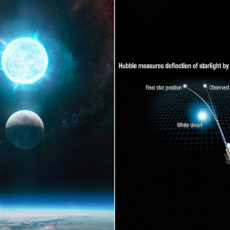
Photo credit: Davide De Martin (ESA/Hubble)
Astronomy fans might be intrigued to know that approximately 8,000 light-years away, located inside the shimmering haze of the NGC 6357 nebula, lies star cluster Pismis 24. It was observed by NASA’s Hubble Space Telescope, and forces scientists to question just how massive a star can get before it breaks the laws of physics.

Pismis 24 lives in a chaotic corner of the galaxy, where its young stars pump out intense ultraviolet radiation that sets the surrounding gas aglow. The cluster’s brightest star, Pismis 24-1, was once thought to be a single beast that packed a mind-boggling 200 to 300 times the mass of our Sun. “That kind of mass would have shattered our models,” says astronomer Jesús Maíz Apellániz, who led the Hubble observations. “Stars that massive should collapse under their own gravity or blow themselves apart.”
- Superior Optics: 400mm(f/5.7) focal length and 70mm aperture, fully coated optics glass lens with high transmission coatings creates stunning images...
- Magnification: Come with two replaceable eyepieces and one 3x Barlow lens.3x Barlow lens trebles the magnifying power of each eyepiece. 5x24 finder...
- Wireless Remote: This refractor telescope includes one smart phone adapter and one Wireless camera remote to explore the nature of the world easily...
The NGC 6357 nebula, Pismis 24’s home, is a turbulent cloud of gas and dust. The cluster’s massive stars blast out radiation and stellar winds that carve glowing cavities as well as intricate shapes into the nebula. “Pismis 24 is like a cosmic sculptor,” says Debra Elmegreen, a Vassar College astronomer who studies star-forming regions. “Its stars are shaping their environment, blasting away gas and triggering new star formation in the process.”
Hubble’s perch above Earth’s atmosphere gives it an edge over ground-based telescopes, which get blurry from air turbulence. That clarity let astronomers see Pismis 24’s stars like never before, confirming that the cluster’s brightest object is a binary system. This discovery cracked open a window into the wild lives of massive stars. Binary systems, where two stars orbit each other, are surprisingly common among these heavyweights, but how they form in such crowded environments is still a mystery. “We’re still trying to figure out how these massive binaries come together in such dense, chaotic environments,” Maíz Apellániz notes. “Pismis 24 is a perfect laboratory for that.”
But Pismis 24 has a poetic side too. In 2020, NASA’s Hubble team turned the cluster’s image into a “sonification,” transforming visual data into sound. Brighter spots became higher-pitched notes, letting the cluster’s stars sing like a cosmic choir. “It’s a way to experience the universe through a different sense,” says Christine Malec, a blind astronomer who worked on the project. “You can hear the density and distribution of stars in Pismis 24, almost like you’re walking through the cluster.”
















